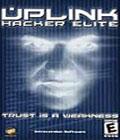Genre: Strategy
Publisher: Strategy First
Developer: Introversion
US Release Date: March 10th 2003
As a computer “hobbyist” who’s had his fair share of FBI visits, Uplink: Hacker Elite seems like an intriguing prospect: work your way through the ranks of elite hackers by remotely infiltrating sensitive computer networks. This isn’t an entirely original concept (Activision released a similar type of PC game titled, simply, “Hacker” nearly 20 years ago), but the people who brought this game together have done so in such a way as to include a surprising amount of authentic dynamics. Hacking isn’t merely a matter of fervently tapping away at a keyboard, attempting to brute force your way through a log-on screen. And Uplink: Hacker Elite solidifies this fact by requiring the player to institute security precautions, specialized software, and powerful hardware in order to progress – all within the confines of a relatively simple strategy-based formula.
The process of progressing through Uplink: Hacker Elite is nonlinear in the sense that you choose what missions you want to take on and how to upgrade your system. But the missions themselves, around which the entire foundation of the game revolves, is incredibly linear; requiring only that you input the correct commands and codes in a specific order within a certain duration of time. You'll start by checking out the mission board which details available hacking jobs. After you accept a job you'll receive an email from the company who solicited it that details the specifics (ie - destroy/copy company data, modify scholastic records, etc). You'll bounce your virtual internet connection through various IP addresses so that you can't be easily traced and then run a password cracking utility at the specific site's log-on screen. Once you gain root access you'll be presented with a simple menu that will allow you to access the server's files and logs. You'll copy/delete/modify a particular file, erase incriminating logs if necessary, and log off. Once you complete the mission you'll receive a certain amount of credits and gain a slight status upgrade.
Not all missions are as cut and dry as copying a particular file or deleting certain information, however. The missions that entail the modification of college records, for example, allow you to sift through emulated on-line records complete with student snapshots. Things get a bit more intricate as you progress through the later portions of the game but for the most part you’ll approach every mission the same; gain access to a server and input a few essential keystrokes. There are certain strategic dynamics at work that help to keep things interesting (logging off before being detected, making sure you have enough storage space to download a particular file, etc), but after three or four missions you’ll have the process down to a science.
By completing missions you’ll accumulate credits that can be spent on hardware and software upgrades. The software upgrades come in the form of new available commands that allow you to bypass firewalls, automatically delete conspicuous logs, and other hacking related programs. Hardware upgrades include bigger "memory banks" so you can store more files, better modems for quicker file transfers, and faster processors to break passwords easier. You can even institute on-site security measures like motion detectors and self-destructive mechanisms to destroy your PC should your cover be blown.
You'll also need to continually upgrade your Exchange Gateway. The Exchange Gateway is basically the computer system you use to do all the hacking. You'll start with a lowly Alpha Gateway system that has no room to upgrade – but as you purchase fancier Gateways more upgrade options will open up, allowing you to get things done faster.
Before you begin taking on missions and building up your hacker status a quick tutorial will guide you through the process of hacking within the game. This tutorial is actually a mission that requires you to log onto a test machine, download a specific file, and delete any logs of your break-in. Once you are finished with this test mission you'll know everything you need to know to progress through the game. There may be more than a slight learning curve involved if basic computer jargon is foreign to you, but any semblance of complication is quickly thrown out the window by the time you’ve completed the test mission.
Visually, Uplink: Hacker Elite is pretty basic, consisting only of a simple text-heavy interface reminiscent of HTML-enabled Bulletin Board Systems. The graphical approach the developers have taken with this game is firmly rooted in reality so there isn’t a lot of focus on artistic design or fancy 3D effects, none in fact. The audio presentation consists of a few subtle musical tracks that fit the cyberpunk theme nicely, like an electronic-sounding SimCity orchestration.
Uplink: Hacker Elite does a lot of things right in recreating the hacker experience but as any warm-blooded hacker, cracker, or phreaker will tell you: a fundamental aspect of hacking revolves around the act of social engineering. Or ones ability to extract pertinent information from unsuspecting targets. This is not represented in the game at all, and that is what ultimately relegates Uplink to a novelty simulation title. Logging into various sites, running a password cracking utility, and performing a few simple tasks on a remote system can quickly grow tiresome. But the strategic aspects of tracking traces, upgrading your hardware and software, etc, can make for an entertaining, if brief, diversion.
Score: 7.6/10
More articles about Uplink: Hacker Elite

































